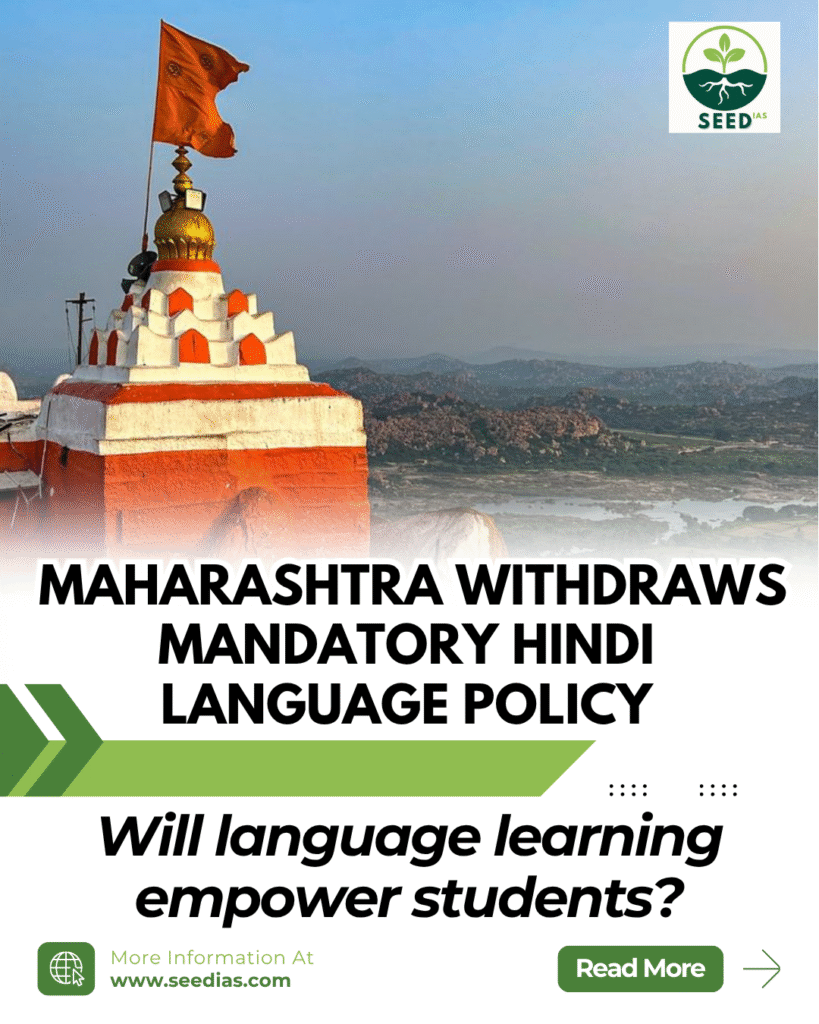Why in NEWS
The Maharashtra government revoked its order mandating Hindi as a compulsory third language from Grades 1 to 5, despite its alignment with NEP 2020. The move was rolled back due to concerns over linguistic identity, cultural imposition, feasibility, and lack of consensus. A committee led by Dr. Narendra Jadhav has been appointed to review the issue.
Key Terms / Concepts
| Term | Explanation |
|---|---|
| Three-Language Policy | A framework promoting the learning of three languages (mother tongue + two others) |
| NEP 2020 | India’s latest National Education Policy emphasizing foundational literacy and flexibility |
| Concurrent List | Subjects where both Centre and States can legislate; education falls here |
| R1 & R2 | In NEP 2020, R1 is the mother tongue/home language; R2 is an additional Indian language |
| Eighth Schedule | Official list of 22 recognized Indian languages under the Constitution |
Challenges in Implementing the Three-Language Policy
| Category | Challenges |
|---|---|
| Pedagogical | Early language exposure ≠ formal instruction; may affect foundational literacy |
| Federal | States allege Hindi imposition; no consultation before mandating third language |
| Cultural | Seen as marginalizing tribal/minority/local languages |
| Administrative | Lack of qualified teachers; difficult to design age-appropriate multilingual curricula |
| Infrastructure | Rural schools especially lack resources to teach three languages effectively |
What NEP 2020 Says About Language
| Focus Area | Details |
|---|---|
| Medium of Instruction | Prefer mother tongue/local language till at least Grade 5, ideally till Grade 8+ |
| Bilingual Education | Encourage a mix of English and home language for better comprehension |
| Flexibility in Policy | No language to be imposed; states can choose languages within the three-language formula |
| Inclusion of Classical & Foreign Languages | Offers classical Indian and international languages at higher grades |
Decline in Mother Tongue Usage in Schools (AISES Data)
| Area | 2002 (%) | 2009 (%) |
|---|---|---|
| Rural | 92.39 | 87.56 |
| Urban | 90.39 | 80.99 |
| Overall | 92.07 | 86.62 |
Constitutional Provisions on Language
| Article | Provision |
|---|---|
| Article 29 | Right to conserve distinct language and culture |
| Article 343 | Hindi is official language; English may continue for Union purposes |
| Article 346 | Official language for Union-State communication (with mutual consent) |
| Article 347 | President can recognize a language as official if large population demands |
| Article 350A | Primary education in mother tongue for linguistic minorities |
| Article 350B | Special Officer for Linguistic Minorities |
| Article 351 | Union to promote and enrich Hindi with other Indian languages |
Arguments FOR and AGAINST Three-Language Policy
| Arguments For | Arguments Against |
|---|---|
| Enhances cognitive skills, flexibility | Perceived as Hindi imposition in non-Hindi states |
| Encourages national integration | Overburdens students and lacks resources |
| Boosts employability across sectors | Practical failure in introducing unrelated languages |
| Supports diversity in education | Politicization and undermining regional identities |
Guiding Principles for an Inclusive Language Policy
| Principle | Approach |
|---|---|
| Institutional Preparedness | Prioritize teaching quality over language quantity |
| Balanced Multilingualism | Avoid defaulting to Hindi; promote reciprocal language learning |
| Skills-Linked Language Use | Link language learning to employability (vocational & digital fluency) |
| Social Justice through Language | Treat language as an empowerment tool, not a tool of hierarchy |
In a Nutshell
Memory Code: L-A-N-G-U-A-G-E
Linguistic Identity at Stake
Administrative Challenges
NEP 2020 Allows Flexibility
Governance Requires Consensus
Universal Access to Quality Learning
Avoid Language Imposition
Grow Multilingual Minds
Equity Must Guide Policy
Prelims Practice Questions
- Which Article directs states to provide primary education in the mother tongue of linguistic minority children?
A. Article 343
B. Article 350A
C. Article 351
D. Article 347 - The Kothari Commission recommended the three-language formula to promote:
A. Technological education
B. Regional identity
C. National integration
D. Religious tolerance - According to NEP 2020, which is true about the three-language formula?
A. Hindi is mandatory across all states
B. States are free to choose any three languages
C. English is banned in primary education
D. Only classical languages are preferred
Mains Practice Questions
- Critically analyze the challenges in implementing the three-language policy in India. Suggest a roadmap for inclusive and context-sensitive language education. 15 Marks (GS2 – Polity & Education)
- Examine the role of language policy in promoting social equity and national integration in India. 10 Marks (GS1 – Society; GS2 – Education Policy)
Prelims Answers with Explanations
| Question | Answer | Explanation |
|---|---|---|
| Q1 | B | Article 350A mandates primary education in mother tongue for linguistic minorities |
| Q2 | C | Kothari Commission’s key objective was national integration through education |
| Q3 | B | NEP 2020 allows states to decide the languages; no imposition mandated |
















